Mike Vardy's Blog, page 53
February 26, 2018
The 3 Ingredients Of A Minimalist Productivity Workflow
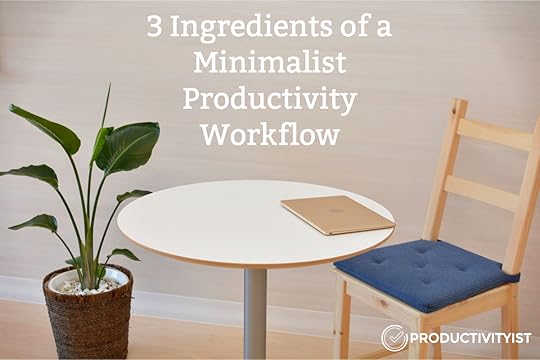
I don’t consider myself to be a minimalist. But when it comes to my personal productivity, I definitely have minimalist tendencies. I align tasks with my time in a way that allows me to move forward with as little friction as possible. I put templates and frameworks in place that reduce decision fatigue so I can leverage every moment of my time. I am very deliberate with the tools I use—both digital and analog—so I know what to use and when to use it.
Being minimalist isn’t about having less to do. It’s about having less stuff in my way so I can do more of those things better.
How My Minimalist Approach Works
What works for me won’t always work for you (which is why I developed TimeCrafting so that you don’t need to adhere to all aspects of it for you to be using the methodology), but I’m certain you’ll find some of the things I mention in this piece helpful. I encourage you to give any or all of these a try so you can find out what does.
My minimalist productivity workflow consists of 3 components:
Align
Bridge
Choose
Each of these components includes strategies that you can integrate into your approach, no matter how many you choose to adopt. Let’s look at each of these components individually.
Align
One of the simplest ways I manage to keep a minimal setup for my productivity is by aligning my tasks to time slots. I do this in various ways through “time theming.” For example, if I’m trying to align tasks up for a long-term project, I’ll use a Monthly Theme to accomplish that.
Over the course of a month, I’ll give emphasis to a specific project. Whenever I do this, I know I have a greater chance of completing the project at hand. Sometimes the Monthly Theme isn’t about finishing a project; it may be about giving it focus. For example, I will conduct workshops and speaking engagements beyond the month of February. When I give that area my attention for the month it allows me to make great progress. After February, I’ll shift focus to another finite or ongoing project and let the workshop/speaking area fade into the background. I encourage you to give theming your months a try so you can see how they align common tasks, which can help you finish projects and achieve goals.
There are other forms of time theming that you can use to align your tasks. Daily Themes allow you to align your tasks to a specific day (or set of days). Horizontal Themes align specific times of day across multiple days–either consecutively or interspersed. Weekly Sprints allow you to focus your tasks on a project or goal over the course of a week rather than a month.
You don’t have to use all the types of time theming that there are available to you. You can choose as few or as many as you want. More on choosing in a moment…
Bridge
How I tackle a task varies depending on a variety of factors. Sometimes it’s based on the Daily Theme, meaning I’ll work on tasks that are aligned with whatever that day’s theme is. For example, I started writing this piece on Friday. Friday is my Deep Work Day so the task “Review Drafts for blog post ideas” is aligned with deep work and therefore is aligned to Fridays. So I can work by task according to their theme.
Sometimes looking at the theme doesn’t work. Maybe I’m tired or traveling (like I am now). Maybe there’s more urgency to the task so it can’t wait until the next instance of its Daily Theme. This is where working by mode, project, or even schedule comes into play. The concept of capturing via The MAPS Mentality helps in these cases because the action (A) can be worked on based on mode (M), project(P), or schedule (S). That’s why when I capture tasks on paper or digital I keep that mentality in mind. Every action requires a mode. If I want to have a bridge for these tasks – another way of approaching them – then I can look at what project they belong to or when they are scheduled and work on them in that fashion.
When you are able to bridge tasks across multiple ways of working on them, then you lower your chances of getting stuck and remove friction and decision fatigue. If you can’t work by schedule, then work by mode or project. Can’t work by project? Work by mode or schedule. Not feeling mode-based work today? Work by project or schedule.
This minimalist productivity workflow creates constraints as opposed to restraints. There’s always a way out or through. That’s because there’s always a bridge for you to take.
Choose
I worked at Costco for years, and one of the hallmarks of the company is that you rarely fell into the trap of analysis paralysis. If you went in to buy ketchup from Costco you had three choices:
The big can of Heinz ketchup
The three-pack of Heinz ketchup
The box of restaurant portion sized ketchup
Don’t like Heinz? You’re not buying ketchup at Costco then. Don’t use a lot of ketchup? Costco’s selections are not for you.
Costco’s lack of choice makes it easier for you to make a choice.
The same can be said for a minimalist productivity workflow. If you focus on creating alignment and ways to bridge then you make it easier to choose not only when things should be done but also whether or not they should be done at all.
Here’s how this worked for me just this week:
Sunday is when I start my week, and I’ve designated it as my Planning Day. I’m currently traveling, so my usual routine is going to be disrupted. So when I looked at my tasks for Sunday I was able to decide what needed my attention. I aligned some tasks with their respective Daily Themes but also attached modes to each of them that ensured I saw them from another angle this week. That way if I decide not to do them on those days I can tackle them when I’m in their respective mode.
Knowing I was traveling this week and having this framework in place also allowed me to be proactive and limit the number of tasks I need to do this week so I can focus my attention on what I want to do this week (my intentions). Going into today I can review my task list and know that I’ve aligned my tasks in multiple ways. That I’ve created bridges that prevent any tasks from falling through the cracks and made choosing what to do when much simpler.
Setting up this kind of workflow isn’t something that takes hold overnight. You need to foster it and stick with it while it becomes second nature. It can be too easy to drag tasks to the next calendar day – which can misalign them – rather than slow down and be mindful of what the best day for them should be. Instead of figuring out the different ways we can approach our to do list, we can get tunnel vision and limit how much we can accomplish as a result. When we don’t create “focus filters” we can wind up creating paradoxes of choice, which slows down what we can do in a given day, week, month, or more.
Being productive is about doing the right things more often. One of the simplest ways you can accomplish this is by creating a framework that only puts in front of you what you must work on in a desired timeframe. So even though you may have a lot to do over an extended period of time, you can set things up so you view what you need and want to do over an intended period of time.
And that will give you the maximum chance of getting the right things done.
The post The 3 Ingredients Of A Minimalist Productivity Workflow appeared first on Productivityist.
February 21, 2018
Rise of the Youpreneur with Chris Ducker
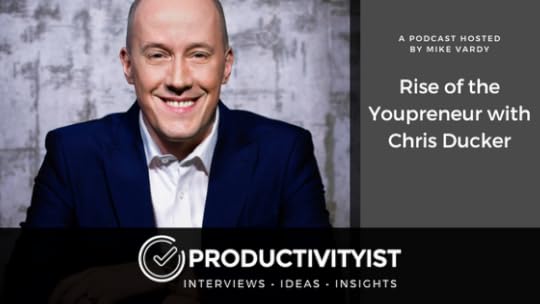
This episode of The Productivityist Podcast is sponsored by Health IQ, an insurance company that helps health conscious people like runners, cyclist, weightlifters and vegetarians get lower rates on their life insurance. Go to healthiq.com/vardy to support the show and see if you qualify.
This week on the podcast, Chris Ducker joins me for another value-packed episode! Chris is a serial entrepreneur, author, keynote speaker, and the founder of Youpreneur.com. He just released a new book titled Rise of The Youpreneur which I truly believe will be a bestseller.
We had a fantastic conversation. Here are a few specific topics we covered:
The rise of the Youpreneur and what that means
What it takes to be a Youpreneur
The role of hard work or hustle
How to course correct
The importance of self-awareness
What Chris is focusing on right now
Why you should wear your heart on your sleeve
Relevant Links:
Rise of the Youpreneur | Amazon
Purchase Rise of the Youpreneur here to get special bonus
ChrisDucker.com | Helping Entrepreneurs Become More Productive and Profitable
Youpreneur: The Entrepreneurial Community Where Nobody Gets Left Behind
How to Launch a Book Guerilla-Style | Page Two Strategies
Youpreneur Mike Vardy | Google Search
The Productivityist Podcast: Fostering Your Inner Youpreneur with Chris Ducker | Productivityist
Supercharging Your Entrepreneurial Productivity with Mike Vardy | ChristDucker.com
Reshaping, Rebuilding and Rebranding Your Business with Mike Vardy | ChrisDucker.com
Thanks for listening. If you enjoyed the show don’t forget to subscribe so you don’t miss a single episode. Until next time remember to stop guessing…and start going!
If you’re interested in supporting the podcast and receiving exclusive content while doing so, you’ll want to check out the patrons-only version of The Productivityist Podcast on Patreon. Also, remember to leave The Productivityist Podcast a rating and review on iTunes, or on whatever platform you’re listening to. I read every single bit of feedback we receive. I want to make this show better and with your help I can do that. If you’d just like to support the podcast on its own, you can do so here.
The post Rise of the Youpreneur with Chris Ducker appeared first on Productivityist.
February 19, 2018
How to Map Out One Year in One Hour
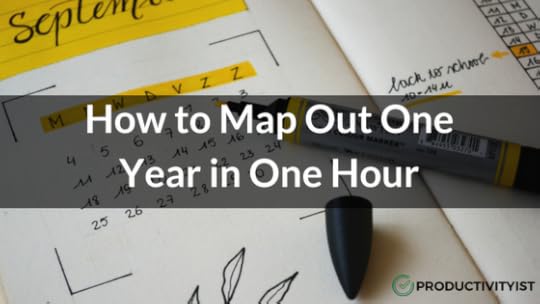
February is almost over. Can you believe it? Each year seems to move faster and faster. Is the year going like you hoped so far? If not, now is the perfect time to adjust.
How can you do that? By planning for the year ahead.
I know your task list is long, and you have a lot on your plate. It may even seem impossible. There’s no chance you can start looking ahead to the months beyond, right?
Wrong.
I’d suggest that it is not only possible for you to start laying plans out for your next year now. You’ve still got plenty of runway left to map out your intentions for the next ten months. So why not do it?
Even though I start my year in September, I’m going to share with you how you can start mapping out the year you want anytime you want in just one hour.
Keep in mind that one hour equals the following:
4.2 percent of a day
.6 percent of a week
.14 percent of a 30 day month
.011 percent of a year
My point is that one hour may seem like a lot, but it isn’t.
Here are the things you need to do up front to make this work:
Schedule the hour. (If you need help choosing an hour, I’ve set aside the perfect time to do this. Just scroll down to the bottom of this email to see the day and hour I’ve chosen for you.)
Make sure you have ZERO interruptions during that hour. Put your phone in Airplane Mode. Turn off all notifications. Close your office door. You must be certain that nothing will get in the way of you mapping out your year over that hour long period.
Get 3 sheets of paper and a pen. You will not need digital devices for this hour of work. You’ll want to have them for the fine-tuning of your planning, but this is simply the mapping of your year that we’re doing over the hour. Save the electronics for afterward.
Once you’ve got all of the above items taken care of you a can start to map out your year. The hour officially starts once you start putting pen to paper.
Here’s what you need to do:
1. Capture the Three Words that you want to embody over the year ahead
This practice was introduced to me by Chris Brogan several years ago. Take one of the sheets of paper and start brainstorming some words that will best represent who you want to be in the year ahead. Take 20 minutes to do this. (Set a timer if you need to.)
2. Capture the big projects you want to accomplish in the year ahead
Take the second sheet of paper and brainstorm all of the major project you want to work on over the next twelve months. These projects can be personal or professional (they can even be both). Write anything that comes to mind on that paper. Take another 20 minutes to do this.
3. Assign the top projects to the months of the year best suited for them
The third sheet of paper is the key. It’s going to be your initial map for the year. Write down all 12 months of the year on that sheet of paper and then assign your most compelling and fulfilling projects to them. Keep in mind that some may take more than one month to complete. Take 20 minutes to do this as well.
There you have it. You have a basic map for your year and that map will help you realize projects that may have sat on the back burner – or were allocated to the wrong time of year – with more focus and attention.
Want to dive even deeper into this? Then check out the course I created to help you start the year you want anytime you want, The NOW Year
Action Plan Course. It’s just $199 and you can learn more about it here.
The post How to Map Out One Year in One Hour appeared first on Productivityist.
February 14, 2018
Riskology with Tyler Tervooren
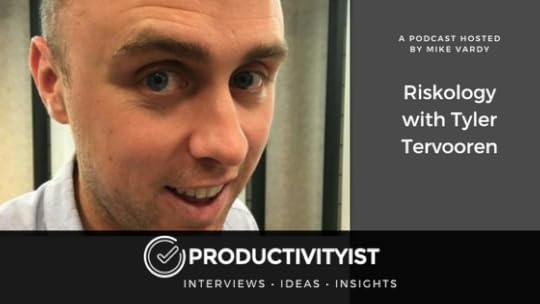
This episode of The Productivityist Podcast is sponsored by Health IQ, an insurance company that helps health conscious people like runners, cyclist, weightlifters and vegetarians get lower rates on their life insurance. Go to healthiq.com/vardy to support the show and see if you qualify.
Tyler Tervooren joins me for a new episode at the Productivityist Podcast! Tyler is a serial entrepreneur, the founder of Riskology, former co-producer of the World Domination Summit – an annual event for free-thinkers and non-conformists, and has completed a marathon on every continent.
Join us on this episode as we spoke about being an introvert leader, how culture is shifting, and more. Here are a few highlights from our conversation:
Why introverts can, in fact, be leaders
How being an introvert is actually an advantage
Why you should be introspective about before looking for resources
Learning to rely more on your intuition
Eliminating self-doubts through small actions
Growth mindset and how it applies to the learning process
Relevant Links:
Riskology
The Top 5 Leadership Challenges of Introverts (and How to Beat Them) | Riskology
Growth Mindset: The Science of Achieving Your Potential| Riskology
Grit: The Power of Passion and Perseverance | Amazon
Tyler Tervooren | Twitter
Thanks for listening. If you enjoyed the show don’t forget to subscribe so you don’t miss a single episode. Until next time remember to stop guessing…and start going!
If you’re interested in supporting the podcast and receiving exclusive content while doing so, you’ll want to check out the patrons-only version of The Productivityist Podcast on Patreon. Also, remember to leave The Productivityist Podcast a rating and review on iTunes, or on whatever platform you’re listening to. I read every single bit of feedback we receive. I want to make this show better and with your help I can do that. If you’d just like to support the podcast on its own, you can do so here.
The post Riskology with Tyler Tervooren appeared first on Productivityist.
February 12, 2018
It’s Okay To Be Busy

“Being busy does not always mean real work. The object of all work is production or accomplishment and to either of these ends there must be forethought, system, planning, intelligence, and honest purpose, as well as perspiration. Seeming to do is not doing.” – Thomas Edison
The word “busy” has become as taboo as another four-letter word that I’ll refrain from using here. And like that coarse four-letter word, it can lose its power and impact when used too frequently.
But being busy is real. It doesn’t always present itself as being occupied with a lot to do, either.
I would say that you can be busy doing deep work like my friend Cal Newport spends much of his time doing. He is busy doing deep work most of the time. He actually argues against being busy in this piece, but I argue that you can be busy doing deep and focused work. At the tail end of the post, Cal says:
“Do less. But do what you do with complete and hard focus. Then when you’re done be done, and go enjoy the rest of the day.”
The term “busy” can be applied to all of what he mentions. You can be busy doing less. You can be busy enjoying the rest of your day. It’s all just in how you frame the word “busy.”
What is Busy?
Busy is defined by Merriam-Webster as being “engaged in action.” Sure, there are other definitions listed, but this is the first one you’ll find. Note that it doesn’t suggest that you’re scattered or overwhelmed – which I believe is what can happen if you have too much to do – but it suggests that if you’re busy you must be engaged in action.
So let’s look at the definition of engaged and action.
Engaged is defined as being “involved” or “committed” to something or someone. As a matter of fact, it can also be defined as being pledged to be married. If you think about being engaged in those terms, then being engaged requires focus. Deep work requires focus, doesn’t it?
There are plenty of definitions of the word “action.” However, for this argument I’m going to run with this one: an act of will.
So if you think about “busy” as being involved or committed to an act of will, then it doesn’t sound nearly as detrimental, does it? It suggests that you’re focused on something that you are doing by desire or by choice.
That sounds pretty productive to me.
What I’m Saying Instead Of “I’m Busy.”
Saying “I’m busy” can become a reflex. I’ve said it more times than I’d like to admit. I still do from time to time. What about you? Is it your default response when people ask how you’re doing? What if someone asks for your help? Do you answer them the same way?
I want to make the word busy matter more. It deserves that because the word has become corrupted over the years. As Edison said, “Being busy does not always mean real work,” but sometimes it does. In those cases, it should have the power and impact needed to illustrate that. Ultimately you want to be able to approach this quotation with something that matters:
”It is not enough to be busy. So are the ants. The question is: What are we busy about?” – Henry David Thoreau
You need to ask yourself that question every time one of these phrases enters your mind:
1. How are you doing?
2. What are you doing?
3. Can you do this?
4. What’s going on?
5. How have you been?
6. When can we get together?
I’m sure there are other questions that others will ask you – or that you can ask yourself – that would result in the answer “I’m busy.”
You need to fend off answering that way. You devalue what you’re doing when you don’t consider what you are, as Thoreau suggests, “busy about.”
What Are You Busy About?
”One of the nice things about being busy is it makes you focus on what’s important to you and how you use your time.” – Lorne Michaels
Lorne Michaels has been running Saturday Night Live for the better part of its 40-plus year history. Most of his life he has spent his time working with a talented cast and crew to create a 90-minute show in a few short days. That’s a tall order to do once, let alone approximately 760 times (as of the end of the 2017 season).
But Michaels’s filmography goes beyond SNL. He’s produced movies, other television programs (like Kids in the Hall), and more. There’s no arguing he is a busy person. The thing is, he’s busy about the right things for him.
Some of the things he is engaged in aren’t necessarily things he desires to do, but he’s committed to them because they are part of the grand scheme of things. Producing content at the pace and rate he does requires many acts of will. Some of those acts are part of the package whether he wants to do them or not. It seems as if Lorne Michaels has got “busy” right. In fact, being busy with the right things has led to his success.
”Success usually comes to those who are too busy to be looking for it.” – Henry David Thoreau
If you were to email me right now what I am busy about, I would share with you my /now page. Even then you’d only get a glimpse of what I’m busy about. TimeCrafting helps me focus on what’s important to me and how I use my time. TimeCrafting has helped me foster awareness and gain clarity on the important things in my life. TimeCrafting helps me define what I’m busy about.
That being said, clearly being busy can be a negative. Let’s look closer at that kind of busy.
The Wrong Kind of Busy
Crazy-busy’ is a great armor, it’s a great way for numbing. What a lot of us do is that we stay so busy, and so out in front of our life, that the truth of how we’re feeling and what we really need can’t catch up with us. – Brene Brown
Busywork is the problem. I think that’s what Brene Brown is referring to when she says “crazy-busy.” It’s not knowing what you’re busy about but being busy for the sake of optics.
It’s taking action without being engaged in it – and doing so repeatedly.
It’s spending time getting your email inbox to zero without being engaged with everything that lands there first. It’s surfing the web without a clear objective in mind before opening the browser. It’s decluttering your space – physical and/or digital – without putting a plan in place first.
The right kind of busy depends on intention before attention. The wrong kind of busy attracts attention before intention.
I can’t define what the right kind of busy is for you. You need to work on that yourself. But I’ve got some ways to help you put intention before attention so you can avoid The ‘Busy’ Trap.
3 Ways to Make Moments Matter
”I would suggest that an ideal human life lies somewhere between my own defiant indolence and the rest of the world’s endless frenetic hustle.” – The ‘Busy’ Trap by Tim Kreider (The New York Times, June 2012)
After re-reading this piece, other words came to mind that I can use instead of “I’m busy.” Words like frenetic, crazy, hectic, and so on. So I’m going to try to avoid simply stating “I’m busy” from now on. Instead, I’ll do one of two things:
1. Qualify what I’m busy about. My /now Page offers up detail as what I’m doing now. I can carry that ideal over to conversations. So if you were to ask me any of those questions I mentioned earlier instead of saying “I’m busy,” and leaving it at that, I will add more depth to the statement. Further to that, I’ll be as succinct as possible when doing so. I won’t rhyme off a list of things I”m busy about but will list one thing that encapsulates several items or – better still – mention one act of will I’m engaged in at the moment.
2. If I’m feeling frenetic, then I’ll use that word instead of busy. I’ve thrown around the term “hecticity” to describe when my life is overly full and frantic. It compels those who care to ask what the word means, and then I can qualify it from there. The big thing is that I’m going to stop saying “I’m busy” on its own as it serves absolutely no one.
I know It will be tough to adopt this habit, but once I apply it consistently, it should stick. There are things I can do to help reinforce my stance on being busy, and you can do them too.
Mindful Meditation
I know that meditation is important, but it’s something I’ve struggled to keep up with regularly. I’ve had it in my head that the more you meditate per session, the better it is for you. That’s not wrong, but I don’t always carve out time for lengthy sessions into my schedule.
There’s no way that I can do an hour of meditation. I’m nowhere near proficient enough to do it and simply don’t want to make that amount of time available for it. I’m not even doing 30 minutes.
Right now I’m doing five minutes.
Five minutes of meditation is where I’m starting my practice again. I may add more as I want to, but the baseline is five minutes. Any amount of meditation is beneficial, so start when you can and see where it takes you.
Intentional Journaling
Another thing I do is journal every evening as my last act for the day. Believe me, it takes some effort to do it daily. The payoff is what makes it worthwhile.
I have written about journaling many times before so I won’t dive in too deep here. Instead, you can check out some of my other pieces on journaling below:
Why I Journal
How To Start And Keep A Journal In Evernot
On Journaling
Taking Journaling To Another Level
This is another act you can engage in for just five minutes a day. How do I know that? Well, there’s a journal that prides itself on that length of time so much it is in its title. So there you have it.
Slow Down (Somewhat)
I’m a big fan of work of Carl Honore. He’s a proponent of doing things slowly. He describes this philosophy below:
”The slow philosophy is not about doing everything in tortoise mode. It’s less about the speed and more about investing the right amount of time and attention in the problem so you solve it.”
The key part of this explanation is understanding the difference between using speed as a metric and using attention as a metric. The focus on speed as a more valuable metric over attention all the time is problematic. It plays a part in the corruption of the word “busy” and lends itself to pushing us towards more busywork.
We can’t slow down too much. We need to be mindful of when and how we slow down. We can do so intermittently over the course of our days, weeks, and months. Activities like disconnecting from devices and going for a walk slow us down. Meditation and journaling slow us down and serve to improve our productivity because of it. Planning – yes, planning – actually slows us down because instead of spending time executing actions, we invest time towards planning the execution of actions.
I’ve long said that personal productivity requires the marriage of intention and attention. Each on their own won’t cut it. Naturally, before those two can be married they need to be engaged first.
So perhaps the best way to make sure you give the phrase “I’m busy” its power back is to say it with this in mind: “I’m busy paying attention to my intentions.”
And then be busy about that.
The post It’s Okay To Be Busy appeared first on Productivityist.
It’s Okay to Be Busy

“Being busy does not always mean real work. The object of all work is production or accomplishment and to either of these ends there must be forethought, system, planning, intelligence, and honest purpose, as well as perspiration. Seeming to do is not doing.” – Thomas Edison
The word “busy” has become as taboo as another four-letter word that I’ll refrain from using here. And like that coarse four-letter word, it can lose its power and impact when used too frequently.
But being busy is real. It doesn’t always present itself as being occupied with a lot to do, either.
I would say that you can be busy doing deep work like my friend Cal Newport spends much of his time doing. He is busy doing deep work most of the time. He actually argues against being busy in this piece, but I argue that you can be busy doing deep and focused work. At the tail end of the post, Cal says:
“Do less. But do what you do with complete and hard focus. Then when you’re done be done, and go enjoy the rest of the day.”
The term “busy” can be applied to all of what he mentions. You can be busy doing less. You can be busy enjoying the rest of your day. It’s all just in how you frame the word “busy.”
What is Busy?
Busy is, at its core, defined as “engaged in action” by Merriam-Webster. Sure, there are other definitions listed, but this is the first one you’ll find. Note that it doesn’t suggest that you’re scattered or overwhelmed – which I believe is what can happen if you have too much to do – but it suggests that if you’re busy you must be engaged in action.
So let’s look at the definition of engaged and action.
Engaged is defined as being “involved” or “committed” to something or someone. As a matter of fact, it can also be defined as being pledged to be married. If you think about being engaged in those terms, then being engaged requires focus. Deep work requires focus, doesn’t it?
There are plenty of definitions of the word “action.” However, for the purposes of this argument I’m going to run with this one: an act of will.
So if you think about “busy” as being involved or committed to an act of will, then it doesn’t sound nearly as detrimental, does it? It suggests that you’re focused on something that you are doing by desire or by choice.
That sounds pretty productive to me.
”I’m Busy”
Saying “I’m busy” can become a reflex. I’ve said it more times than I’d like to admit. I still do from time to time. What about you? Is it your default response when people ask how you’re doing? What if someone asks for your help? Do you answer them the same way?
I want to make the word busy matter more. It deserves that because the word has become corrupted over the years. As Edison said, “Being busy does not always mean real work,” but sometimes it does. In those cases, it should have the power and impact needed to illustrate that. Ultimately you want to be able to approach this quotation with something that matters:
”It is not enough to be busy. So are the ants. The question is: What are we busy about?” – Henry David Thoreau
You need to ask yourself that question every time one of these phrases enters your mind:
1. How are you doing?
2. What are you doing?
3. Can you do this?
4. What’s going on?
5. How have you been?
6. When can we get together?
I’m sure there are other questions that others will ask you – or that you can ask yourself – that would result in the answer “I’m busy.”
You need to fend off answering that way. You devalue what you’re doing when you don’t consider what you are, as Thoreau suggests, “busy about.”
What Are You Busy About?
”One of the nice things about being busy is it makes you focus on what’s important to you and how you use your time.” – Lorne Michaels
Lorne Michaels has been running Saturday Night Live for the better part of its 40-plus year history. Most of his life has been occupied with working with a talented cast and crew to create a 90 minute show in a few short days. That’s a tall order to do once, let alone approximately 760 times (as of the end of the 2017 season).
But Michaels’s filmography goes beyond SNL. He’s produced movies, other television programs (like Kids in the Hall), and more. There’s no arguing he is a busy person. The thing is, he’s busy about the right things for him.
Some of the things he is engaged in aren’t necessarily things he desires to do, but he’s committed to them because they are part of the grand scheme of things. Producing content at the pace and rate he does requires many acts of will. Some of those acts are part of the package whether he wants to do them or not. It seems as if Lorne Michaels has got “busy” right. In fact, being busy with the right things has led to his success.
”Success usually comes to those who are too busy to be looking for it.” – Henry David Thoreau
If you were to email me right now what I am busy about, I would share with you my /now page. Even then you’d only get a glimpse of what I’m busy about. TimeCrafting helps me focus on what’s important to me and how I use my time. TimeCrafting has helped me foster awareness and gain clarity on the important things in my life. TimeCrafting helps me define what I’m busy about.
That being said, clearly being busy can be a negative. Let’s look closer at that kind of busy.
The Wrong Kind of Busy
Crazy-busy’ is a great armor, it’s a great way for numbing. What a lot of us do is that we stay so busy, and so out in front of our life, that the truth of how we’re feeling and what we really need can’t catch up with us. – Brene Brown
Busywork is the problem. I think that’s what Brene Brown is referring to when she says “crazy-busy.” It’s not knowing what you’re busy about but being busy for the sake of optics.
It’s taking action without being engaged in it – and doing so repeatedly.
It’s spending time getting your email inbox to zero without being engaged with everything that lands there first. It’s surfing the web without a clear objective in mind before opening the browser. It’s decluttering your space – physical and/or digital – without putting a plan in place first.
The right kind of busy depends on intention before attention. The wrong kind of busy attracts attention before intention.
I can’t define what the right kind of busy is for you. You need to work on that yourself. But I’ve got some ways to help you put intention before attention so you can avoid The ‘Busy’ Trap.
3 Ways to Make Moments Matter
”I would suggest that an ideal human life lies somewhere between my own defiant indolence and the rest of the world’s endless frenetic hustle.” – The ‘Busy’ Trap by Tim Kreider (The New York Times, June 2012)
After re-reading this piece other words came to mind that I can use instead of “I’m busy.” Words like frenetic, crazy, hectic, and so on. So I’m going to try to avoid simply stating “I’m busy” from now on. Instead, I’ll do one of two things:
1. Qualify what I’m busy about. My /now Page offers up detail as what I’m doing now. I can carry that ideal over to conversations. So if you were to ask me any of those questions I mentioned earlier instead of saying “I’m busy,” and leaving it at that, I will add more depth to the statement. Further to that, I’ll be as succinct as possible when doing so. I won’t rhyme off a list of things I”m busy about but will list one thing that encapsulates several items or – better still – mention one act of will I’m engaged in at the moment.
2. If I’m feeling frenetic, then I’ll use that word instead of busy. I’ve thrown around the term “hecticity” to describe when my life is overly full and frantic. It compels those who care to ask what the word means, and then I can qualify it from there. The big thing is that I’m going to stop saying “I’m busy” on its own as it serves absolutely no one.
I know It will be tough to adopt this habit, but once I apply it consistently, it should stick. There are things I can do to help reinforce my stance on being busy, and you can do them too.
1. Meditation
I know that meditation is important, but it’s something I’ve struggled to keep up with regularly. I’ve had it in my head that the more you meditate per session, the better it is for you. That’s not wrong, but I don’t always carve out time for lengthy sessions into my schedule.
There’s no way that I am able to do an hour of meditation. I’m nowhere near proficient enough to do it and simply don’t want to make that amount of time available for it. I’m not even doing 30 minutes.
Right now I’m doing five minutes.
Five minutes of meditation is where I’m starting my practice again. I may add more as I want to, but the baseline is five minutes. Any amount of meditation is beneficial, so start when you can and see where it takes you.
2. Journaling
Another thing I do is journal every evening as my last act for the day. Believe me, it takes some effort to do it daily. The payoff is what makes it worthwhile.
I have written about journaling many times before so I won’t dive in too deep here. Instead, you can check out some of my other pieces on journaling below:
LIST JOURNALING POSTS
Why I Journal
How To Start And Keep A Journal In Evernote
On Journaling
Taking Journaling To Another Level
This is another act you can engage in for just five minutes a day. How do I know that? Well, there’s a journal that prides itself on that length of time so much it is in its title. So there you have it.
3. Slow Down (Somewhat)
I’m a big fan of work of Carl Honore. He’s a proponent of doing things slowly. He describes this philosophy below:
”The slow philosophy is not about doing everything in tortoise mode. It’s less about the speed and more about investing the right amount of time and attention in the problem so you solve it.”
The key part of this explanation is understanding the difference between using speed as a metric and using attention as a metric. The focus on speed as a more valuable metric over attention all the time is problematic. It plays a part in the corruption of the word “busy” and lends itself to pushing us towards more busywork.
We can’t slow down too much. We need to be mindful of when and how we slow down. We can do so intermittently over the course of our days, weeks, and months. Activities like disconnecting from devices and going for a walk slow us down. Meditation and journaling slow us down and serve to improve our productivity because of it. Planning – yes, planning – actually slows us down because instead of spending time executing actions, we invest time towards planning the execution of actions.
I’ve long said that personal productivity requires the marriage of intention and attention. Each on their own won’t cut it. Naturally, before those two can be married they need to be engaged first.
So perhaps the best way to make sure you give the phrase “I’m busy” its power back is to say it with this in mind: “I’m busy paying attention to my intentions.”
And then be busy about that.
The post It’s Okay to Be Busy appeared first on Productivityist.
February 7, 2018
Magnetic Memorization with Dr. Anthony Metivier
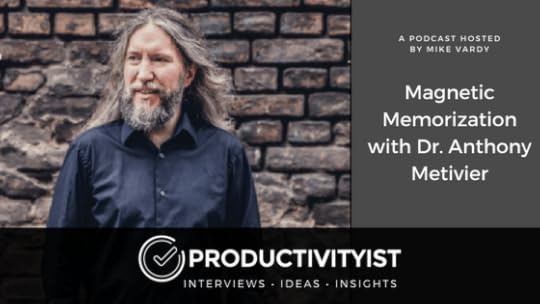
This episode of The Productivityist Podcast is sponsored by Health IQ, an insurance company that helps health conscious people like runners, cyclist, weightlifters and vegetarians get lower rates on their life insurance. Go to healthiq.com/vardy to support the show and see if you qualify.
This week’s episode is with Anthony Metivier, founder of the Magnetic Memory Method, a systematic, 21st Century approach to memorizing foreign language vocabulary, dreams, names, music, poetry and much more in ways that are easy, effective and fun.
We spoke about how your memory can affect your personal productivity as well as how to optimize your memory. Here are a few highlights from this episode:
Memorizing your entire to-do list vs. memorizing certain items
Learning memory techniques for vocabulary, numbers, names, facts, and details about others
When you strengthen your memory like a muscle, it also strengthens your mind.
The power found in memorizing a deck of cards
Using visuals as memory tools and turning numbers into words
The Magnetic Memory method and how it works
Why intentionality is essential for memorization
Memory and information overload
Why you should know focus on how you learn
Relevant Links:
Magnetic Memory Method
The Free Memory Improvement Kit
What’s Your Learning Style
Anthony Metivier | Twitter
Anthony Metivier | Youtube
Thanks for listening. If you enjoyed the show don’t forget to subscribe so you don’t miss a single episode. Until next time remember to stop guessing…and start going!
If you’re interested in supporting the podcast and receiving exclusive content while doing so, you’ll want to check out the patrons-only version of The Productivityist Podcast on Patreon. Also, remember to leave The Productivityist Podcast a rating and review on iTunes, or on whatever platform you’re listening to. I read every single bit of feedback we receive. I want to make this show better and with your help I can do that. If you’d just like to support the podcast on its own, you can do so here.
The post Magnetic Memorization with Dr. Anthony Metivier appeared first on Productivityist.
February 5, 2018
My Three Words for 2018 (and a Single Resolution)
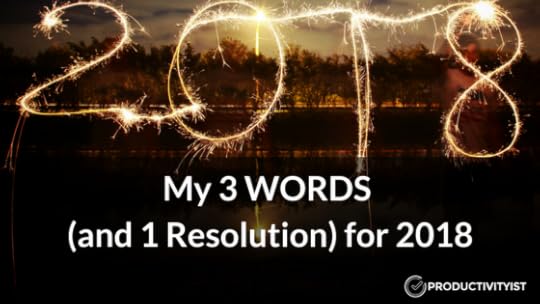
There are several reasons why this post nearly didn’t get written.
First, I don’t usually make resolutions to start off the year. Second, I don’t begin my year in January. I also don’t find yearlong resolutions to be helpful – there are numerous studies that outline how resolutions often don’t work.
So this year after I went through the Yearly Words exercise – something I feature in my “anytime” annual planning program The NOW Year Action Plan Course – I decided to use the same three words from 2017 in 2018.
However, I did change my stance on resolutions. I decided to make one resolution for this calendar year: To be more resolute.
I’m going to be more resolute with my Monthly Themes, ensuring that I give them my overarching focus during those 28-day to 31-day spans of time.
I’m going to be more resolute with my Weekly Sprints, seeing that they override the Monthly Theme and allowing me to focus intensely on the subject of the sprint over the 7 days of the week.
I’m going to be more resolute with my Daily Themes, aligning tasks with each of them so that every day has a greater sense of flow and purpose because they are defined and designed.
I’m going to be more resolute with my Horizontal Themes, making them consistent and stationed in a way that things like fitness and writing get attention as often as I know they should.
And I’m going to be more resolute so that my 3 Words for the year have staying power over the long haul because there were times in the previous twelve months that they did not.
The Same Words
As I sat down to work through my words for the year (a practice I’ve adopted from Chris Brogan over the years), I followed my usual practice where I distill a mission and/or vision statement for a 12-month cycle down to three simple, yet engrossing, words.
These words are engrossing in that they should be able to contain smaller words inside of them. For example, in 2014 one of my words was Focus. That word can apply to personal and professional goals and projects (and ideals, for that matter). It can also contain other words like Clarity and Awareness, among others. Ultimately, Focus won out because it simply “felt right” over and above other words. It sat alongside Family and Forward as my Three Words for 2014 – and even those other two words could arguably cover a wide gamut of other words.
When I started reviewing my possible words for the year ahead (which I did back in August for a September start date), the words Redesign, Rebuild, and Reclaim kept coming back to the forefront. It’s as if they had some unfinished business left to attend to and they weren’t ready to go away like their predecessors.
I struggled with this initially, trying to find other words that could represent them in a new and fresh way. I even considered deviating from my usual pattern of having all three words begin with the same letter.
Redesign could be Upgrade, Renew, or Reset. Rebuild could be Self-Care, Attention, or Service. Reclaim could be Improve, Challenge, or Cultivate. Those alternatives arose simply from a thesaurus search. They also could include virtues such as Integrity, Industry, Tranquility, and more.
But ultimately the incumbent words won out.
I felt as if the words were right: they had unfinished business. I’m still in the process of redesigning, rebuilding, and reclaiming. It’s not something that I believe I could have done in 365 days. In fact, I think the elements of those words – the things they represent – have a much longer shelf life than that.
The Value of Reflecting on Your Words
I’m glad that I go through this exercise every year. Even if I chose the same words as last year, there is value in taking time to both inspect and reflect.
It reminds me of how my son Colton counts his money every week.
Every week he gets a small allowance, and he adds it to his wallet. But before he does that, he takes the time to count its contents. He does that every week, without fail. It’s not as if he isn’t capable of adding the numbers together; he’s quite good at math. He also has an excellent memory – which we’ve become acutely aware of – so it’s not that, either.
He simply wants to see everything in front of him again as he adds something new to the mix.
He likes to see it all in front of him as he adds a little bit more to the pile. Then he totals it up and starts thinking about what he could do with it. He starts to do some of the math for some of the toys he might want to buy, figuring out if it will work or if it won’t. He thinks about how long it took him to acquire this money and starts to figure out how long it will take to buy the toy he wants.
I think that taking time to figure out what words you will use to guide your year – and even beyond – it’s a lot like that.
You need to revisit them regularly so that you don’t lose sight of them. They need to be something you can build upon so that you can make great things happen for yourself and those around you. You need to make sure that they are getting the attention they deserve so that you can use them to help you with your intentions.
So no matter what words you choose for yourself, make sure you find a way to keep them in front of you so that you can be more resolute with them going forward.
Do that and, as the late legendary football coach Bill Walsh said, “the score will take care of itself.”
The post My Three Words for 2018 (and a Single Resolution) appeared first on Productivityist.
January 31, 2018
The View from the Top with Aaron Walker
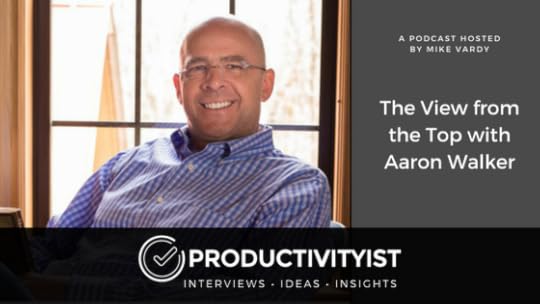
In this week’s episode, I spoke with life and business coach Aaron Walker. He spends the majority of his time helping men grow in success and significance as President and Founder of View From The Top, a premier life, and business coaching resource. We spoke about ambition, clarity, living a life of success and more. It was a great conversation that I’m sure you’ll get a lot out of.
Some of the topics we talked about are:
The myth of work-life balance
On being ambitious about the right things
Why it’s important to focus both outward and inward
Designing a proactive life through journaling
Deep diving instead of doing as much as possible
Why there is no power in wisdom–there is power in the execution of wisdom
Relevant Links:
Aaron Walker – View from the Top
What Do I Want Sheet
Aaron Walker | Facebook
Aaron Walker | Twitter
Procrastinate on Purpose: 5 Permissions to Multiply Your Time
Never Split the Difference: Negotiating as if Your Life Depended on it
Big Leap: Conquer Your Hidden Fear and Take Life to the Next Level
Mindset: The New Psychology of Success
Essentialism: The Disciplined Pursuit of Less
The Go-Giver: A Little Story About a Powerful Business Idea
Thanks for listening. If you enjoyed the show don’t forget to subscribe so you don’t miss a single episode. Until next time remember to stop guessing…and start going!
If you’re interested in supporting the podcast and receiving exclusive content while doing so, you’ll want to check out the patrons-only version of The Productivityist Podcast on Patreon. Also, remember to leave The Productivityist Podcast a rating and review on iTunes, or on whatever platform you’re listening to. I read every single bit of feedback we receive. I want to make this show better and with your help I can do that. If you’d just like to support the podcast on its own, you can do so here.
The post The View from the Top with Aaron Walker appeared first on Productivityist.
January 24, 2018
Undoing Things with Alison Stratten
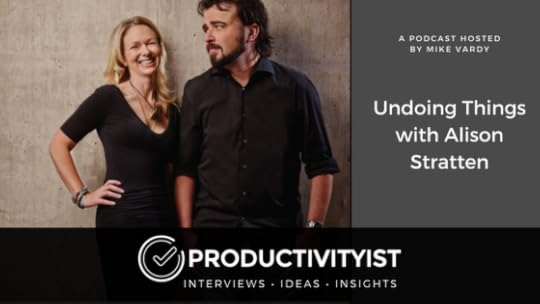
On this episode of the podcast, I’m joined by Alison Stratten of Unmarketing. Alison is a writer, marketer, podcaster, parent and also a fellow Canadian. I had a great time talking with her.
Here are a few highlights from the show:
The line between personal information and business marketing
The roles of work and family
Alison’s story
How the Stratten’s work behind the scenes
Relevant Links:
Unmarketing: Stop Marketing, Start Engaging
Unmarketing | Facebook
Unpodcast – The Business Show for the Fed Up | Youtube
Alison Stratten | Twitter
Thanks for listening. If you enjoyed the show don’t forget to subscribe so you don’t miss a single episode. Until next time remember to stop guessing…and start going!
If you’re interested in supporting the podcast and receiving exclusive content while doing so, you’ll want to check out the patrons-only version of The Productivityist Podcast on Patreon. Also, remember to leave The Productivityist Podcast a rating and review on iTunes, or on whatever platform you’re listening to. I read every single bit of feedback we receive. I want to make this show better and with your help I can do that.
The post Undoing Things with Alison Stratten appeared first on Productivityist.



